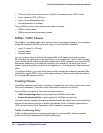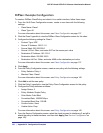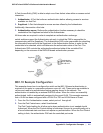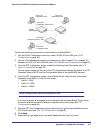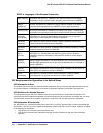
264 | Appendix B: Configuration Examples
GS716Tv2 and GS724Tv3 Software Administration Manual
An MST Region comprises of one or more MSTP Bridges with the same MST Configuration
Identifier, using the same MSTIs, and which have no Bridges attached that cannot receive
and transmit MSTP BPDUs. The MST Configuration Identifier has the following components:
1. Configuration Identifier Format Selector
2. Configuration Name
3. Configuration Revision Level
4. Configuration Digest: 16-byte signature of type HMAC-MD5 created from the MST
Configuration Table (a VLAN ID to MSTID mapping)
As there are Multiple Instances of Spanning Tree, there is a MSTP state maintained on a
per-port, per-instance basis (or on a per port per VLAN basis: as any VLAN can be in one and
only one MSTI or CIST). For example, port A can be forwarding for instance 1 while
discarding for instance 2. The port states have changed since IEEE 802.1D specification.
To support multiple spanning trees, a MSTP bridge has to be configured with an
unambiguous assignment of VLAN IDs (VIDs) to spanning trees. This is achieved by:
1. Ensuring that the allocation of VIDs to FIDs is unambiguous.
2. Ensuring that each FID supported by the Bridge is allocated to exactly one Spanning Tree
Instance.
The combination of VID to FID and then FID to MSTI allocation defines a mapping of VIDs to
spanning tree instances, represented by the MST Configuration Table.
With this allocation we ensure that every VLAN is assigned to one and only one MSTI. The
CIST is also an instance of spanning tree with a MSTID of 0.
An instance may occur that has no VIDs allocated to it, but every VLAN must be allocated to
one of the other instances of spanning tree.
The portion of the active topology of the network that connects any two bridges in the same
MST Region traverses only MST bridges and LANs in that region, and never Bridges of any
kind outside the Region, in other words connectivity within the region is independent of
external connectivity.
MSTP Example Configuration
This example shows how to create an MSTP instance from the GS716T or GS724T switch.
The example network has three different GS716T or GS724T switches that serve different
locations in the network. In this example, ports e1–e5 are connected to host stations, so
those links are not subject to network loops. Ports e6–e8 are connected across switches 1, 2,
and 3.



